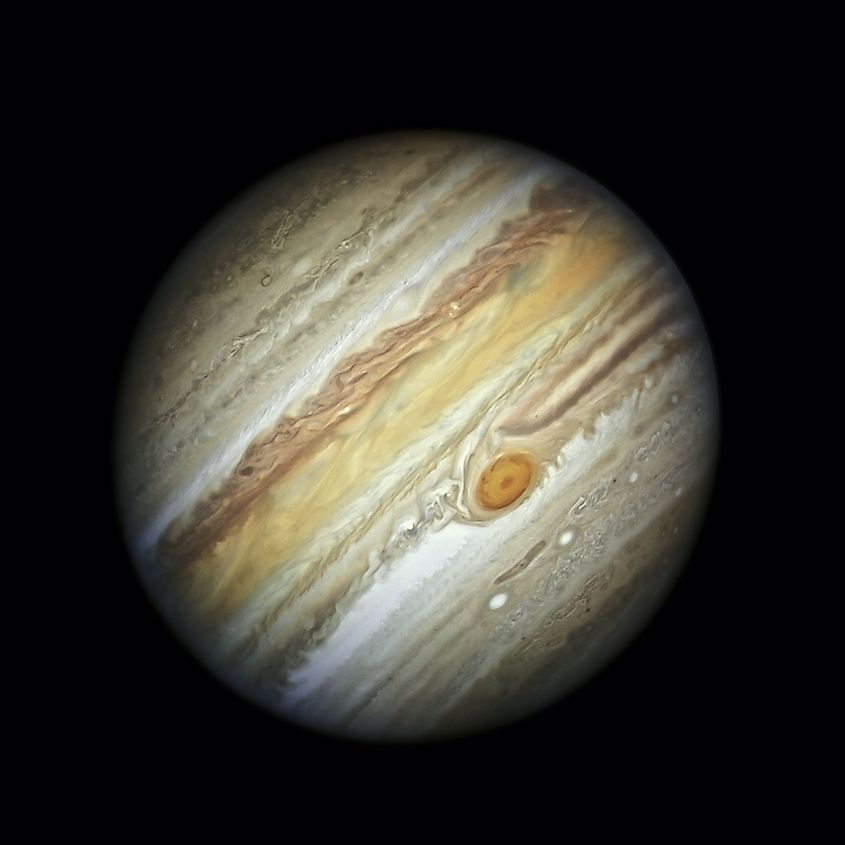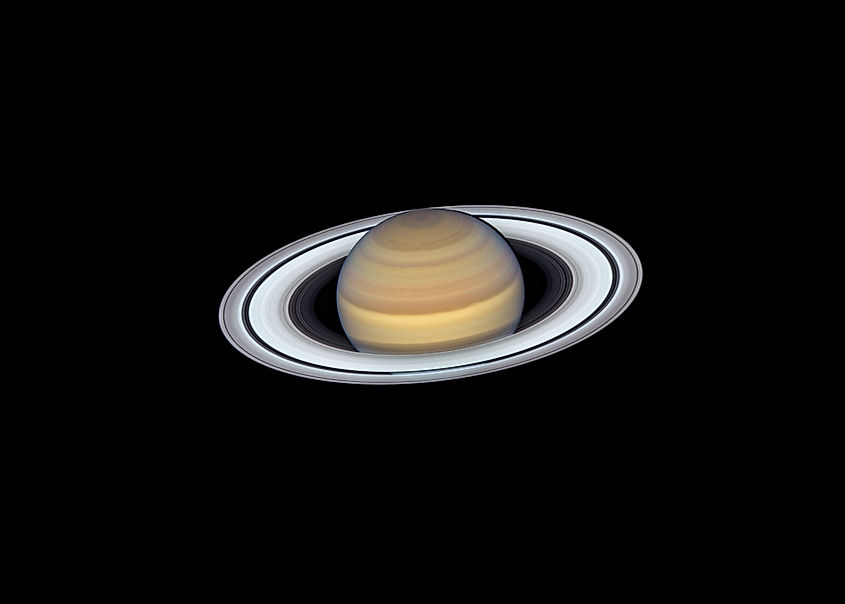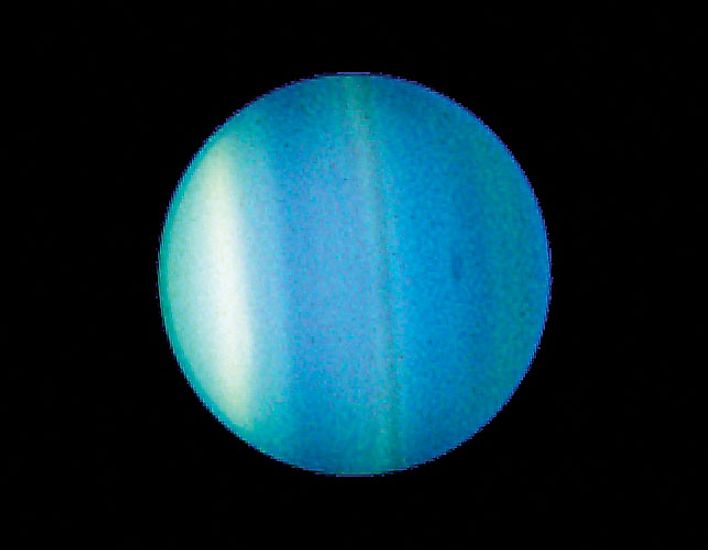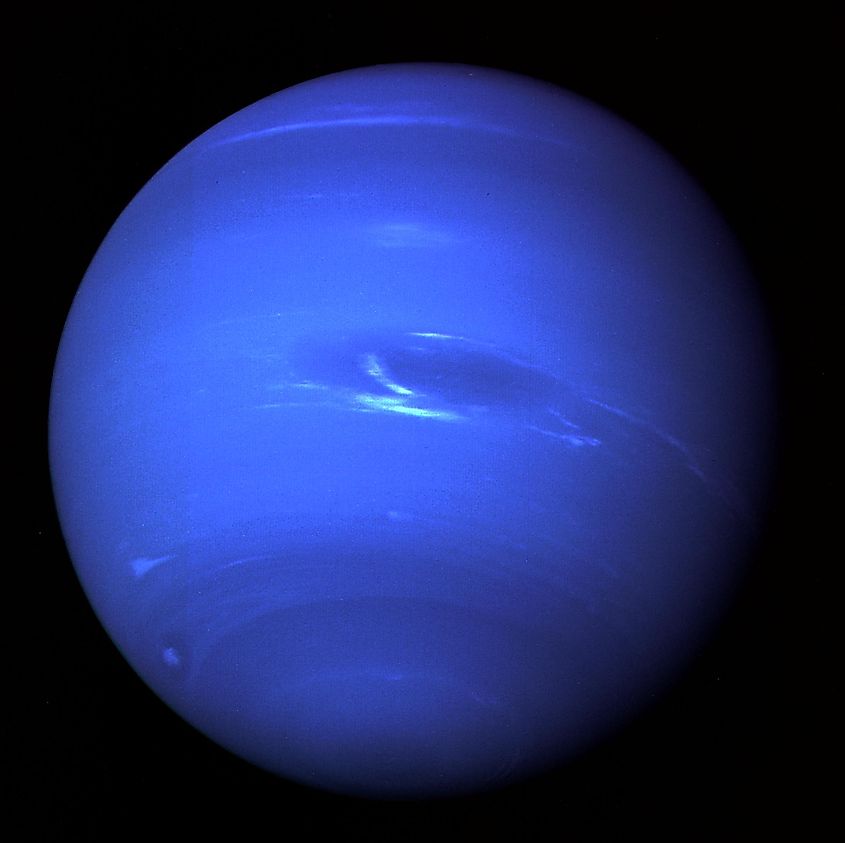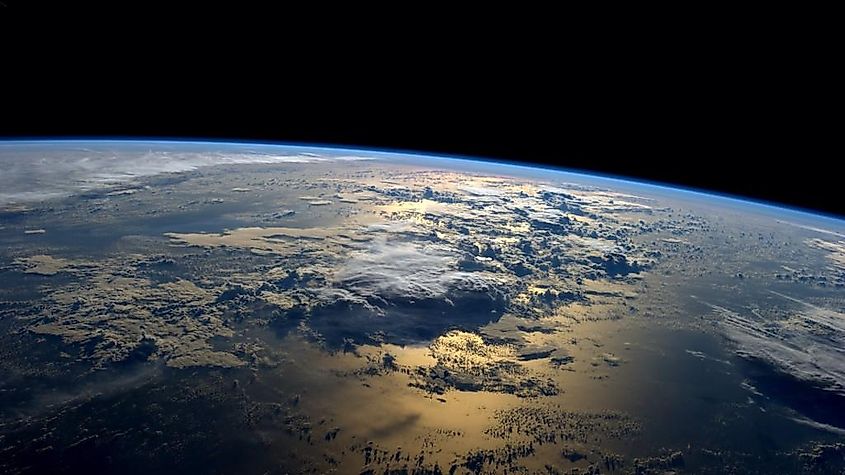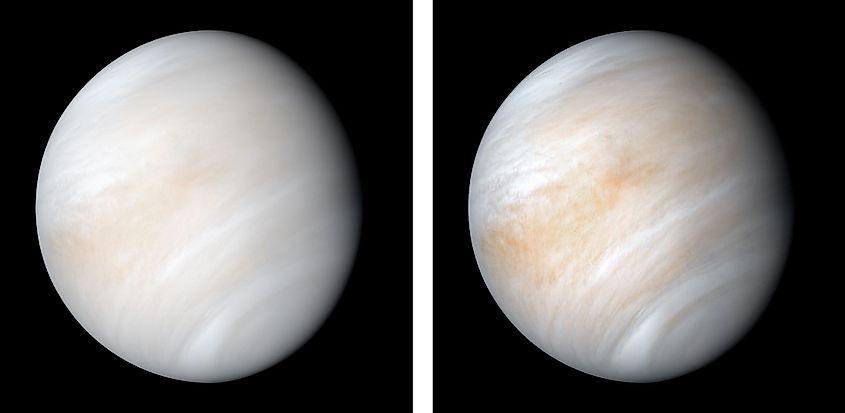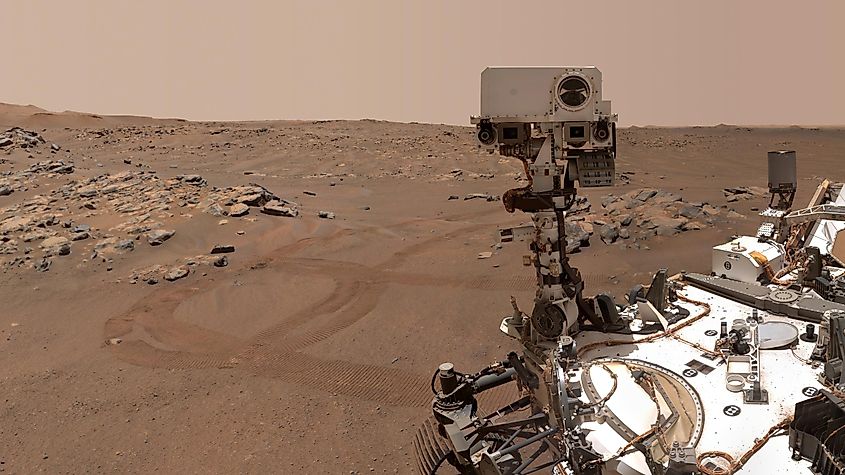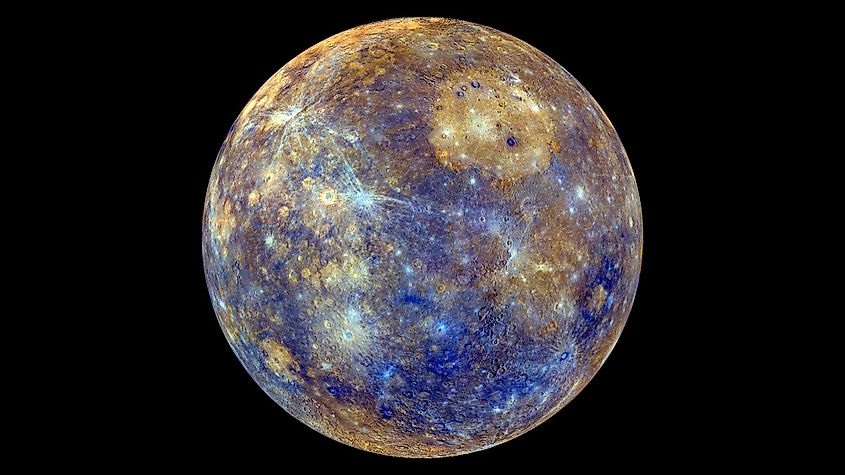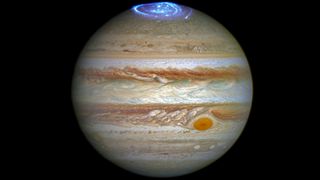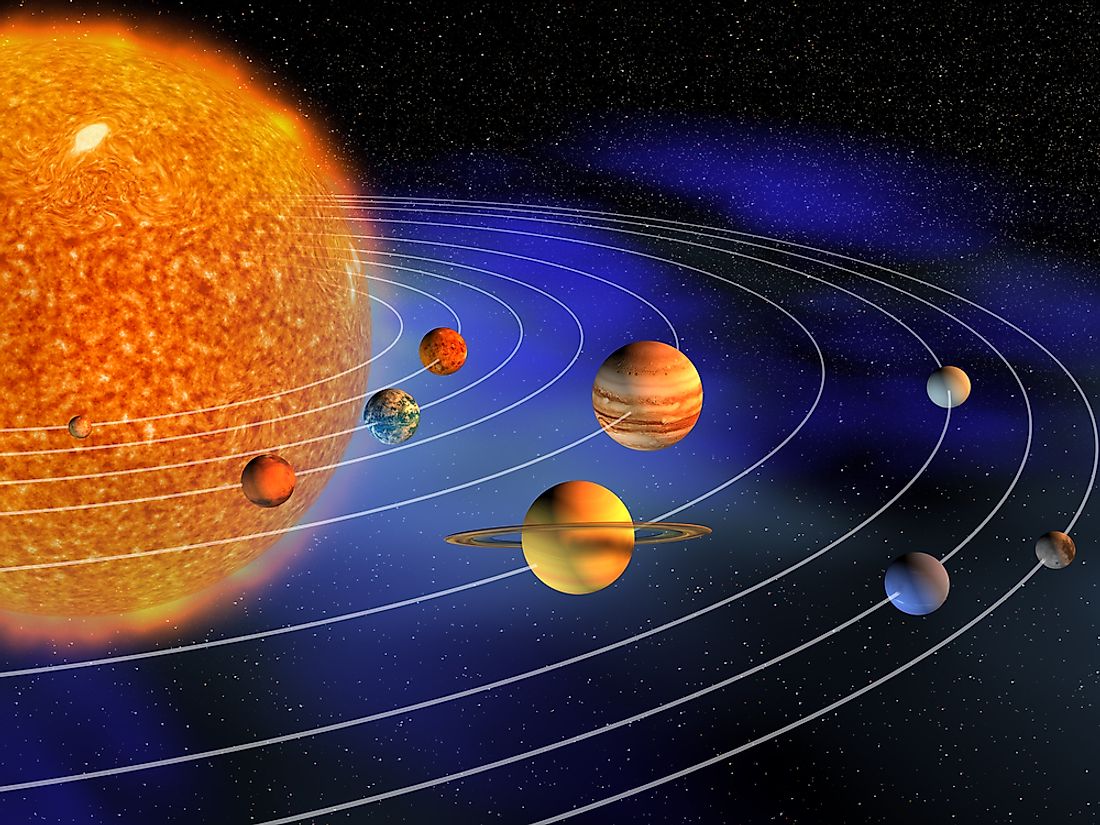What is the largest planet in the solar system
What is the largest planet in the solar system
What Is The Largest Planet In The Solar System?
The eight planets in our solar system come in a wide variety of sizes. Some are true behemoths, while others are relatively small. Which planets are the biggest and which are the smallest?
Jupiter as Captured by the Hubble Telescope, NASA
Jupiter is the largest planet in our solar system by size, mass, and volume. By size, Jupiter is gigantic, having a diameter of 142,800 kilometers or about 11 Earths across. In terms of volume, you could fit every other planet inside Jupiter, and there would still be space left over. Jupiter is more than 300 times the mass of the Earth.
Jupiter was able to grow to its current size, likely due to its location in the solar system. Shortly after the Sun formed, its energy pushed lighter elements towards the outer solar system. Hydrogen and helium, the two most lightweight elements in the universe, could not stay in the inner solar system and were instead pushed away by the Sun’s energy. Since there is a far higher amount of hydrogen and helium than any other element, they existed in large amounts in the outer solar system, allowing the outer gas giants to grow to immense sizes.
Like the Sun, Jupiter is composed mainly of hydrogen and helium. These two elements make up over 90% of Jupiter’s composition. In addition to being the largest planet, Jupiter also has the strongest magnetic field of all the planets. If humans could see Jupiter’s magnetic field, it would be one of the brightest objects in the night sky. Jupiter also has the fastest rotation in the solar system, spinning once about its axis every 10-hours. It’s this fast rotation that causes Jupiter to have the long bands of gas that are scattered throughout its atmosphere. Jupiter’s rotation is so fast that it stretches the gas in Jupiter’s atmosphere, creating the long bands that make Jupiter so recognizable.
Saturn as Captured by the Hubble Telescope, NASA
Saturn is the second-largest planet in our solar system, with a diameter of 120,660 kilometers, or about 9.5 Earths across. By volume, you could fit 764 Earths inside Saturn. By mass, Saturn is 95 times the mass of Earth.
The reasons behind Saturn becoming such a giant planet are the same as those for Jupiter. The outer solar system contained vast amounts of hydrogen and helium, allowing planets like Jupiter and Saturn to become the largest planets in the solar system. Interestingly, Jupiter and Saturn are probably the two most similar planets in the solar system. Both are composed chiefly of hydrogen and helium and are covered in large bands of gas. However, Saturn’s bands are not nearly as prominent as Jupiter’s. Like Jupiter, Saturn also rotates fast, completing one rotation every 11-hours. With such a quick rotation, the process by which the large bands of gas form are similar to Jupiter. However, due to Saturn’s further distance from the Sun, it does not receive as much sunlight, which may contribute to how these large bands form. Furthermore, the distribution of some chemicals, such as water, ammonia, and sulfur, may also contribute to Saturn’s watered-down appearance.
Uranus as Captured by the Hubble Telescope, NASA
Uranus is the third-largest planet in the solar system, with a diameter of 51,118 kilometers, or about four Earths across. Despite being only four times larger than Earth, Uranus is still a massive planet at 14.5 times the mass of Earth.
Like Jupiter and Saturn, Uranus is composed mostly of hydrogen and helium. However, although Uranus is also a gas giant, it contains a much higher abundance of water, methane, and ammonia when compared to Jupiter and Saturn. As a result, Uranus belongs to another classification of planets called ice giant. Uranus was the first planet to be discovered using a telescope. In 1781, the astronomer William Herschel discovered Uranus. Uranus has only ever been visited by a spacecraft once, the Voyager 2 flyby, in the 1980s. Most of what scientists know about Uranus was discovered during Voyager 2’s flyby. Unlike Jupiter and Saturn, Uranus was virtually featureless. It had no large bands spread across its atmosphere and no visible storm systems. For the most part, Uranus appeared rather dull. As it later turned out, Voyager 2 simply had bad timing. Uranus experiences seasonal changes as it orbits the Sun, and future observations from Hubble have revealed atmospheric features and storms. One of the most interesting properties of Uranus is that the entire planet is tipped on its side. Unlike the other planets, Uranus does not rotate from side to side. Instead, its axis is flipped a full 90 degrees. Visually, Uranus rolls around the Sun like a wheel.
NASA’s Constructed Photo of Neptune from Voyager 2 Images
Neptune is the fourth-largest planet in the solar system, with a diameter of 49,528 kilometers, or about 3.8 Earths across. Interestingly, despite being smaller than Uranus, Neptune is more massive. Neptune has a mass seventeen times that of the Earth, while Uranus is just over 14 times as massive as Earth. Given Neptune’s location in the solar system, it makes no sense why it’s more massive than Uranus. Being so far from the Sun makes it unlikely that there would have been enough material for Neptune to become as huge as it is. It is generally believed that Neptune formed closer to the Sun than Uranus, and over time, the two planets swapped places due to the gravitational forces between them and the other gas giants.
Like the other three gas giants, Neptune is composed mostly of hydrogen and helium. Like Uranus, Neptune is classified as an ice giant due to its higher abundance of things like water, methane, and ammonia. Interestingly, the higher abundance of methane in Neptune’s atmosphere is why the planet is so blue. The methane absorbs red light from the Sun and scatters blue light, giving Neptune its signature color.
An Image of Earth Tweeted by Astronaut Wiseman from the International Space Station, NASA
Earth is the fifth-largest planet in our solar system, with a diameter of 12,756 kilometers. The Earth is the largest and heaviest of the four inner rocky worlds. The Earth is also the densest planet in the solar system. Earth’s high density comes from the fact that Earth contains an abundance of heavy metals, with the core being composed mostly of iron. Earth is one of the only planets in the solar system that is geologically active, causing the surface of the Earth to change over time as the continents drift across the surface.
The Earth is the only planet in the solar system that orbits within the Sun’s habitable zone. The habitable zone is the area around a star where, given the right conditions, water can exist in liquid form on a planet’s surface. The Earth is nearly covered in water, with 75% of the surface being water. The existence of so much liquid water has allowed for the presence and evolution of life, and the Earth is the only world known so far to harbor life.
Venus as Captured by NASA’s Mariner 10 Spacecraft
Venus is the sixth largest planet in the solar system, with a diameter of 12,104 kilometers, or about 95% the size of Earth. In terms of size and composition, Venus and Earth are very similar. Both are rocky worlds that contain an iron core. However, despite their similarities, Venus has sometimes been called Earth’s «evil twin.» That’s because Venus does not possess the life-giving environment of the Earth. Instead, Venus is the warmest planet in the solar system, having an average surface temperature of 900 degrees Fahrenheit (475 degrees Celsius). Venus is even warmer than Mercury, despite Mercury being closer to the Sun than Venus. The high surface temperature of Venus is a result of its atmospheric composition and density. Not only is the atmosphere 90 times heavier than Earth’s, but it is also 96% carbon dioxide. As a greenhouse gas, carbon dioxide traps incoming heat from the Sun and keeps it near the surface, causing temperatures on Venus to skyrocket.
An Image of Mars Taken by NASA’s Perseverance Land Rover
Mars is the seventh-largest planet in the solar system, with a diameter of 6,779 kilometers, or about half the size of Earth. The Earth and Mars are very similar worlds. Both are composed primarily of rock and metal, both have a 24-hour day, and Mars likely had large amounts of water on its surface in the distant past. Mars has undergone numerous changes throughout its history. It once had a thick atmosphere with large amounts of oxygen, which allowed Mars to have rivers, lakes, and even oceans of liquid water. Billions of years ago, Mars would not have looked that different from Earth. Life may have arisen on Mars, but scientists have not found any evidence of past or current forms of life on Mars.
A Colorful View of Mercury, Produced from Images Taken by the MESSENGER’s primary mission, NASA
Mercury is the smallest planet in the solar system, with a diameter of 4,849 kilometers, or about 38% the size of Earth. Mercury is also the closest planet to the Sun at an average of 48-million kilometers. Being so close to the Sun, Mercury can’t hold onto an atmosphere, making it difficult for Mercury to disperse the heat it receives from the Sun. The result is that Mercury experiences some of the most dramatic temperatures in the solar system. During the day, temperatures reach as high as 800 degrees Fahrenheit (450 degrees Celsius), while at night, temperatures drop as low as minus 290 degrees Fahrenheit (minus 180 degrees Celsius).
Jupiter: A guide to the largest planet in the solar system
The gas giant has 79 moons and is known as the ‘king of the planets’.
Jupiter is the largest planet in the solar system and the fifth planet from the sun. The gas giant has a long, rich, history of surprising scientists.
Named after the kind of the gods in Roman mythology this «king of the planets» is a stormy enigma shrouded in colorful clouds. Its most prominent and most famous storm, the Great Red Spot, is twice the width of Earth.
Jupiter helped to revolutionize the way we saw the universe — and our place in it — in 1610 when Galileo discovered Jupiter’s four large moons: Io, Europa, Ganymede and Callisto. These observations were the first time that celestial bodies were seen circling an object other than Earth and supported the Copernican view that Earth was not the center of the universe.
Since 2016, the NASA spacecraft Juno has been investigating Jupiter and its moons.
How big is Jupiter?
Jupiter is more than twice as massive as all the other planets combined, according to NASA. Jupiter’s immense volume could hold more than 1,300 Earths. If Jupiter were the size of a basketball, Earth would be the size of a grape.
Jupiter was probably the first planet to form in the solar system, made up of gasses left over from the formation of the sun. If the planet had been about 80 times more massive during its development, it would have actually become a star in its own right, according to NASA.
How far is Jupiter from the sun?
On average, Jupiter orbits at about 483,682,810 miles (778,412,020 kilometers) from the sun. That’s 5.203 times farther than Earth’s average distance from the sun.
At perihelion, when Jupiter is closest to the sun, the planet is 460,276,100 miles (740,742,600 km) away.
At aphelion or the farthest distance that Jupiter reaches from the sun, it is 507,089,500 miles (816,081,400 km) away.
Jupiter’s environment
Jupiter’s atmosphere resembles that of the sun, made up mostly of hydrogen and helium. A helium-rich layer of fluid metallic hydrogen envelops a “fuzzy” or partially-dissolved core at the center of the planet.
The colorful light and dark bands that surround Jupiter are created by strong east-west winds in the planet’s upper atmosphere traveling more than 335 mph (539 km/h). The white clouds in the light zones are made of crystals of frozen ammonia, while darker clouds made of other chemicals are found in the dark belts. At the deepest visible levels are blue clouds. Far from being static, the stripes of clouds change over time.
Inside the atmosphere, saturn.html» style=»text-decoration: underline; box-sizing: border-box;»>diamond rain may fill the skies, and hidden deep within the atmosphere is a dense core of unknown composition.
Jupiter’s gargantuan magnetic field is the strongest of all the planets in the solar system, at nearly 20,000 times the strength of Earth’s, according to the University of Colorado at Boulder. The magnetic field traps electrons and other electrically charged particles in an intense belt that regularly blasts the planet’s moons and rings with radiation more than 1,000 times the level lethal to a human. The radiation is severe enough to damage even heavily shielded spacecraft, such as NASA’s Galileo probe. The magnetosphere of Jupiter swells out some 600,000 to 2 million miles (1 million to 3 million km) toward the sun and tapers to a tail extending more than 600 million miles (1 billion km) behind the massive planet.
The star-tracker camera aboard NASA’s Juno spacecraft captured this view of Jupiter’s faint rings on Aug. 27, 2016, during the probe’s first data-gathering close approach to the giant planet. It’s the first-ever view of the planet’s rings from inside of them. The bright star above the main ring is Betelgeuse, and Orion’s belt can be seen in the lower right.
What is the Great Red Spot?
One of Jupiter’s most famous features is the Great Red Spot, a giant hurricane-like storm that’s lasted more than 300 years. According to NASA, the Great Red Spot at its widest is about twice the size of Earth, and its edge spins counterclockwise around its center at speeds of about 270 to 425 mph (430 to 680 kph). That counterclockwise spin makes it a type of storm called an «anticyclone.»
The color of the storm, which usually varies from brick red to slightly brown, may come from small amounts of sulfur and phosphorus in the ammonia crystals in Jupiter’s clouds. The spot has been shrinking for quite some time, although the rate may be slowing in recent years.
Jupiter has many other storms, too. According to 2022 data from Juno, Jupiter’s gargantuan polar cyclones are driven by convection or heat rising from lower altitudes to the higher atmosphere, similar to the way ocean vortexes work on Earth.
Jupiter’s moons
Jupiter has a mind-boggling 79 known moons, mostly named after the paramours and descendants of the Roman god of the same name. The four largest moons of Jupiter called Io, Europa, Ganymede and Callisto, were discovered by Galileo Galilei and so are sometimes called the Galilean moons.
Ganymede is the largest moon in our solar system, and is larger than both Pluto and Mercury. It is also the only moon known to have its own magnetic field, whose eerie sound NASA’s Juno mission captured in 2021. The moon has at least one ocean between layers of ice, although according to a 2014 study from the journal Planetary and Space Science, it may contain several layers of ice and water stacked on top of one another, along with atmospheric water vapor first spotted in 2021. Ganymede will be the main target of the European Jupiter Icy Moons Explorer (JUICE) spacecraft scheduled to launch in 2023 and arrive at Jupiter’s system in 2030.
Io is the most volcanically active body in our solar system. As Io orbits Jupiter, the planet’s immense gravity causes «tides» in Io’s solid surface that rise 300 feet (100 meters) high and generate enough heat to spur on volcanism. Those volcanoes release more than one ton of material every second into the space around the moon, helping to create strange radio waves from Jupiter. The sulfur its volcanoes spew gives Io a blotted yellow-orange appearance, leading some to compare it to a pepperoni pizza.
The frozen crust of Europa is made up mostly of water ice, and it may hide a liquid ocean that contains twice as much water as Earth’s oceans do. Some of this liquid spouts from out of Europa’s southern pole in sporadic plumes, and in 2021 the Hubble Space Telescope spotted more water vapor above Europa’s surface. Also in 2021, Europa’s north pole was photographed for the first time, and the discovery of underwater volcanoes raised hopes that Europa could be hospitable to life.
With the National Oceanic and Atmospheric Administration (NOAA) and the Woods Hole Oceanographic Institute, NASA may someday send an autonomous submersible to explore Europa’s ice-covered oceans. Additionally, NASA’s Europa Clipper mission, a planned spacecraft that would launch in the 2020s, would perform 40 to 45 flybys to examine the habitability of the icy moon.
Callisto has the lowest reflectivity, or albedo, of the four Galilean moons. This suggests that its surface may be composed of dark, colorless rock. Once considered a boring counterpart to the other Galilean moons, Callisto’s heavily-cratered surface might conceal a secret ocean, according to NASA.
Jupiter’s rings
Jupiter’s three faint rings came as a surprise when NASA’s Voyager 1 spacecraft discovered them around the planet’s equator in 1979. Much more tenuous than Saturn’s chunky, colorful rings, Jupiter’s rings are made of continuous streams of dust particles emitted by some of the planet’s moons, according to NASA’s Goddard Space Flight Center.
The main ring is flattened, according to the Southwest Research Institute’s (SwRI’s) Juno Mission website. It is about 20 miles (30 km) thick and more than 4,000 miles (6,400 km) wide.
The inner donut-shaped (also called “toroidal”) ring, called the halo, is more than 12,000 miles (20,000 km) thick, wrote SwRI. The halo is caused by electromagnetic forces that push grains away from the plane of the main ring. Both the main ring and halo are composed of small, dark particles of dust.
The third ring, known as the gossamer ring because of its transparency, is actually three rings of microscopic debris from three of Jupiter’s moons: Amalthea, Thebe and Adrastea. According to a press release from NASA’s Galileo mission, the gossamer ring is probably made up of dust particles about the same size as the particles found in cigarette smoke, and extends to an outer edge of about 80,000 miles (129,000 km) from the center of the planet and inward to about 18,600 miles (30,000 km).
Ripples in the rings of both Jupiter and Saturn may be signs of impacts from comets and asteroids.
Exploring Jupiter
NASA’s Juno mission arrived at Jupiter in 2016 with an intended lifespan of about 20 months in orbit, but as of 2022 continues to return beautiful images, audio and other data, with its mission extended until 2025.
Historically, seven missions have flown by Jupiter — Pioneer 10, Pioneer 11, Voyager 1, Voyager 2, Ulysses, Cassini and New Horizons. Only two missions — NASA’s Galileo and Juno — have orbited the planet.
Pioneer 10 revealed how dangerous Jupiter’s radiation belt is, while Pioneer 11 provided data on the Great Red Spot and close-up pictures of Jupiter’s polar regions. Voyagers 1 and 2 helped astronomers create the first detailed maps of the Galilean satellites, discovered Jupiter’s rings, revealed sulfur volcanoes on Io and detected lightning in Jupiter’s clouds. Ulysses discovered that the solar wind has a much greater impact on Jupiter’s magnetosphere than scientists previously thought. New Horizons took close-up pictures of Jupiter and its largest moons.
Jupiter’s first orbiter, Galileo, arrived in 1995 and soon sent a probe plunging toward Jupiter, making the first direct measurements of the planet’s atmosphere and measuring the amount of water and other chemicals there. Then the main spacecraft spent eight years studying the system. When Galileo itself ran low on fuel, the spacecraft intentionally crashed into Jupiter to avoid any risk of it bringing contamination from Earth to Europa, which might have an ocean below its surface capable of supporting life.
Now, Juno studies Jupiter from a polar orbit, in part to figure out how it and the rest of the solar system formed. Researchers hope the mission could also shed light on how alien planetary systems might have developed. According to data from Juno, Jupiter’s core may be larger than scientists expected, while Jupiter’s stripes and storms stretch from high in the atmosphere to deep inside the planet. In a 2021 NASA overview (opens in new tab) of Juno’s biggest hits, the agency also included observing lightning on Jupiter, detecting water in the atmosphere and measuring magnetic fields 10 times stronger than any found on Earth.
Although no missions dedicated to Jupiter itself are in the works, two future spacecraft will study Jupiter’s moons: NASA’s Europa Clipper (which would launch in the mid-2020s) and the European Space Agency’s Jupiter Icy Moons Explorer (JUICE) which will launch in 2023 and arrive at Jupiter’s system in 2030 to study Ganymede, Callisto and Europa.
Researchers say that the gas giant will also be a «proving ground» for the James Webb Space Telescope (JWST). Scientists are eager to explore Jupiter during the first year of scientific observations of the powerful telescope. With Webb’s sights set on exploring Jupiter and its moons scientists are excited at the prospect of understanding some of Jupiter’s greatest mysteries such as how such a massive storm — the Great Red Spot — forms in the turbulent atmosphere or how its largest moons may harbor oceans of water of hidden volcanoes.
On July 14, 2022, the JWST team released a few tantalizing photos of Jupiter that were captured during the commissioning period. In some of the images, Jupiter’s thin ring structure and its moons Europa, Thebe and Metis, are captured through JWST’s NIRCam.
How did Jupiter shape our solar system?
As the most massive body in the solar system after the sun, Jupiter has helped shape the fate of our neighborhood in space with its immense gravity.
Jupiter’s gravity has been found responsible for slinging Neptune and Uranus (along with a host of smaller objects like asteroids) away from the sun, according to a 2005 paper published in the journal Nature. That paper established a theory of «planetary genealogy» called the Nice model, named after the French city where it was developed.
According to the Nice model, Jupiter and other gas giants were also responsible for the Late Heavy Bombardment, a period of time when the young planet Earth and its nearby fellows were barraged with debris.
Could there be life on Jupiter?
Jupiter’s atmosphere grows warmer with depth, reaching room temperature, or 70 degrees Fahrenheit (21 degrees Celsius), at an altitude where the atmospheric pressure is about 10 times as great as it is on Earth. Scientists suspect that if Jupiter has any form of life, it would have to be airborne at this level. Theoretically, a 2021 study found, that there is enough water to support some life. However, researchers have found no evidence of life on Jupiter.
Jupiter’s moons are a different story: Europa in particular could host a radiation-shielded hidden ocean, and marine life might float somewhere in those alien waters.
Additional resources and reading
Read this 2018 interview from PBS NewsHour (opens in new tab) with JunoCam’s lead scientist Candice Hansen-Koharchek, who connects the camera aboard NASA’s Juno mission to the public and lets anyone participate in the science around Jupiter. For more on Jupiter’s possible past as a major mover-and-shaker in the solar system, read this overview article published in 2020 by the journal Proceedings of the National Academy of Sciences (opens in new tab) that discusses both the Nice model and newer theories of Jupiter’s history. Writer Marina Koren discovers that Jupiter’s Great Red Spot might actually be more of a pale rosy color in this piece from The Atlantic (opens in new tab) on the true colors of the solar system. And for an in-depth video look at the solar system’s biggest planet, check out the Jupiter episode of NOVA (opens in new tab) ‘s «The Planets» series, narrated by actor Zachary Quinto.
The Largest Planet In Solar System
Our solar system has eight planets with a lot many of planetoids, also referred to as dwarf planets. The most significant feature that allows us to call something as planet is that it has gravitational force, is big enough in size and orbits in the same plane. The largest planet in the solar system is Jupiter. As per Roman mythology Jupiter is named as the ruler of gods.
Planets
Jupiter is the largest planet in the solar system. Though the volume of the largest planet is 1400 times of earth, its mass is only 318 times. It means that its density is nearly one fourth of earth, indicating that the planet must comprise of gases and not rocks and metals which are found on earth and other inner planets. 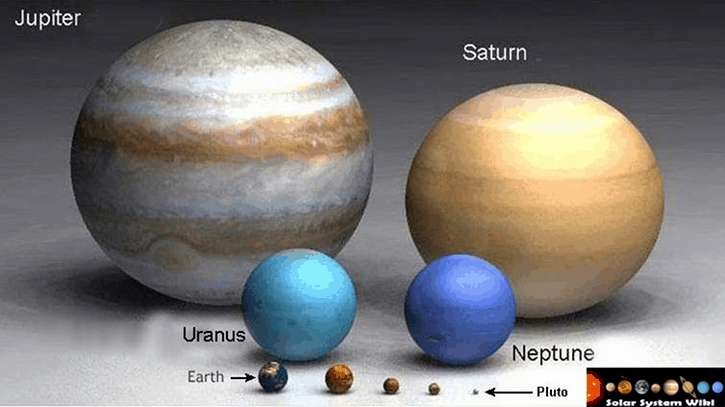
Some interesting facts about the biggest planet: Jupiter
Jupiter’s Spot
This biggest planet is characterized by a big red spot, called Jupiter’s Great Red Spot. In fact, this red spot is a massive storm which Jupiter has continued to bear since more than four hundred years. Three times the size of our earth, this red spot is the largest and most violent storm known to the universe. The winds of this storm can reach speeds of up to 270 miles per hour.
Being gaseous, Jupiter’s atmosphere is comparable to an ocean of gases. The currents taking place in the gases are like winds on earth and the cause of Jupiter’s constantly changing swirls. The winds are very colorful but we do not know the precise reason for that. Some attribute those colors to the fast speeds at which the planet rotate while others believe that it is due internal heat created in the planet. Scientific explanation that the colorful atmosphere is created due presence of phosphorus and sulfur in planet’s atmosphere sounds more convincing.
Rings on Jupiter
As a consequence of Voyager’s visit to outer planets of our solar system we realized that all planets containing gases have rings and Jupiter is no exception, though the rings in case of the largest planet in solar system are very thin and thus less visible.
Jupiter: the Largest Planet in the Solar System
A diagram showing the planets of the solar system, with Jupiter showing prominence as the largest planet.
There are eight recognized planets in the solar system. Each planet has unique features that distinguish itself from other planets. One of the features is the diameter size of the planets. Jupiter is the planet with the longest diameter, therefore it is the largest planet in the solar system.
Rank of the planets
The following are planets in descending order based on their size.
Jupiter
The universe’s largest planet is Jupiter, which has a diameter of 142,800 meters. It has colored patterns of clouds formed by the massive, swirling atmospheric storms. Helium and hydrogen are the main contents of the interior part of the planet. Jupiter also has a faint ring system and 63 moons orbiting the planet.
Saturn
Saturn has a diameter of 120,660 meters. Its interior part mainly contains the liquid helium and hydrogen formed due to the high pressure. Saturn has 62 moons orbiting the planet alongside the complex and an extensive set of rings.
Uranus
Uranus is a planet that has unique seasonal variations because it spins on a plane with the sun’s orbit. Its diameter is 51,118 meters and it contains a significant amount of methane in its atmosphere. The planet is cold and there are 27 moons that orbit it alongside a faint ring system.
Neptune
Neptune is the furthest planet from the sun with a diameter of 59,528 meters. It is a very cold planet since it is far from the sun. Besides, Neptune’s atmosphere contains a large amount of methane, making the planet blue. Thirteen moons orbit the planets alongside a faint ring system.
Earth
Earth is a terrestrial planet that has a diameter of 12,756 meters. It is the only planet that supports life and has liquid water on its surface. The Earth has living beings since its atmosphere contains the important gases for life (Oxygen, Nitrogen, and Carbon (IV) Oxide).
Venus
Venus is located second from the sun and with a diameter of 12,104 meters. The planet’s surface is hot (approximately 900℉) and cratered. Venus’ atmosphere is very thick in its Carbon (IV) Oxide and sulfuric acid content. Unfortunately, Venus is inhabitable since the air pressure in its atmosphere is very high, ninety times the Earth’s atmospheric pressure to be specific.
Mercury
Mercury has a diameter of 4,879 meters which makes it the smallest of the planets. Since it is very close to the sun, the temperature of Mercury’s cratered surface can reach 800℉. Mercury does not have rings or moons but it has a very thin atmosphere.
Planets’ types
Terrestrial and gas giant planets are the two main categories of planets. The first four planets from the sun are the terrestrial planets. The other four planets fall under the category of giant planets. These planets are large mainly due to their large atmospheres that have small and icy cores.
What is the Biggest Planet in the Solar System?
Ever since the invention of the telescope four hundred years ago, astronomers have been fascinated by the gas giant of Jupiter. Between it’s constant, swirling clouds, its many, many moons, and its Giant Red Spot, there are many things about this planet that are both delightful and fascinating.
But perhaps the most impressive feature about Jupiter is its sheer size. In terms of mass, volume, and surface area, Jupiter is the biggest planet in our Solar System by a wide margin. But just what makes Jupiter so massive, and what else do we know about it?
Size and Mass:
Remove All Ads on Universe Today
Get the ad-free experience for life
But, being a gas giant, Jupiter has a relatively low density – 1.326 g/cm 3 – which is less than one quarter of Earth’s. This means that while Jupiter’s volume is equivalent to about 1,321 Earths, it is only 318 times as massive. The low density is one way scientists are able to determine that it is made mostly of gases, though the debate still rages on what exists at its core (see below).
Composition:
Jupiter is composed primarily of gaseous and liquid matter. It is the largest of the gas giants, and like them, is divided between a gaseous outer atmosphere and an interior that is made up of denser materials. Its upper atmosphere is composed of about 88–92% hydrogen and 8–12% helium by percent volume of gas molecules, and approx. 75% hydrogen and 24% helium by mass, with the remaining one percent consisting of other elements.
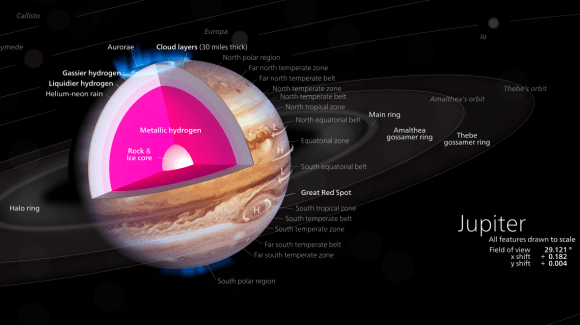
The atmosphere contains trace amounts of methane, water vapor, ammonia, and silicon-based compounds as well as trace amounts of benzene and other hydrocarbons. There are also traces of carbon, ethane, hydrogen sulfide, neon, oxygen, phosphine, and sulfur. Crystals of frozen ammonia have also been observed in the outermost layer of the atmosphere.
The interior contains denser materials, such that the distribution is roughly 71% hydrogen, 24% helium and 5% other elements by mass. It is believed that Jupiter’s core is a dense mix of elements – a surrounding layer of liquid metallic hydrogen with some helium, and an outer layer predominantly of molecular hydrogen. The core has also been described as rocky, but this remains unknown as well.
In 1997, the existence of the core was suggested by gravitational measurements, indicating a mass of from 12 to 45 times the Earth’s mass, or roughly 4%–14% of the total mass of Jupiter. The presence of a core is also supported by models of planetary formation that indicate how a rocky or icy core would have been necessary at some point in the planet’s history in order to collect its bulk of hydrogen and helium from the protosolar nebula.
However, it is possible that this core has since shrunk due to convection currents of hot, liquid, metallic hydrogen mixing with the molten core. This core may even be absent now, but a detailed analysis is needed before this can be confirmed. The Juno mission, which launched in August 2011, is expected to provide some insight into these questions, and thereby make progress on the problem of the core.
The temperature and pressure inside Jupiter increase steadily toward the core. At the “surface”, the pressure and temperature are believed to be 10 bars and 340 K (67 °C, 152 °F). At the “phase transition” region, where hydrogen becomes metallic, it is believed the temperature is 10,000 K (9,700 °C; 17,500 °F) and the pressure is 200 GPa. The temperature at the core boundary is estimated to be 36,000 K (35,700 °C; 64,300 °F) and the interior pressure at roughly 3,000–4,500 GPa.
Moons:
The Jovian system currently includes 67 known moons. The four largest are known as the Galilean Moons, which are named after their discoverer, Galileo Galilei. They include: Io, the most volcanically active body in our Solar System; Europa, which is suspected of having a massive subsurface ocean; Ganymede, the largest moon in our Solar System; and Callisto, which is also thought to have a subsurface ocean and features some of the oldest surface material in the Solar System.
Then there’s the Inner Group (or Amalthea group), which is made up of four small moons that have diameters of less than 200 km, orbit at radii less than 200,000 km, and have orbital inclinations of less than half a degree. This groups includes the moons of Metis, Adrastea, Amalthea, and Thebe. Along with a number of as-yet-unseen inner moonlets, these moons replenish and maintain Jupiter’s faint ring system.
Jupiter also has an array of Irregular Satellites, which are substantially smaller and have more distant and eccentric orbits than the others. These moons are broken down into families that have similarities in orbit and composition, and are believed to be largely the result of collisions from large objects that were captured by Jupiter’s gravity.

Interesting Facts:
Much like Earth, Jupiter experiences auroras near its northern and southern poles. But on Jupiter, the auroral activity is much more intense and rarely ever stops. The intense radiation, Jupiter’s magnetic field, and the abundance of material from Io’s volcanoes that react with Jupiter’s ionosphere creates a light show that is truly spectacular.
Jupiter also has a violent atmosphere. Winds in the clouds can reach speeds of up to 620 kph (385 mph). Storms form within hours and can become thousands of km in diameter overnight. One storm, the Great Red Spot, has been raging since at least the late 1600s. The storm has been shrinking and expanding throughout its history; but in 2012, it was suggested that the Giant Red Spot might eventually disappear.
The discovery of exoplanets has revealed that planets can get even bigger than Jupiter. In fact, the number of “Super Jupiters” observed by the Kepler space probe (as well as ground-based telescopes) in the past few years has been staggering. In fact, as of 2015, more than 300 such planets have been identified.
Notable examples include PSR B1620-26 b (Methuselah), which was the first super-Jupiter to be observed (in 2003). At 12.7 billion years of age, it is also the third oldest known planet in the universe. There’s also HD 80606 b (Niobe), which has the most eccentric orbit of any known planet, and 2M1207b (Lerna), which orbits the brown dwarf Fomalhaut b (Illion).
Scientist theorize that a gas gain could get 15 times the size of Jupiter before it began deuterium fusion, making it a brown dwarf star. Good thing too, since the last thing the Solar System needs if for Jupiter to go nova!
Jupiter was appropriately named by the ancient Romans, who chose to name after the king of the Gods (Jupiter, or Jove). The more we have come to know and understand about this most-massive of Solar planets, the more deserving of this name it appears.
If you’re wondering, here’s how big planets can get with a lot of mass, and here’s what is the biggest star in the Universe. And here’s the 2nd largest planet in the Solar System.
We have recorded a whole series of podcasts about the Solar System at Astronomy Cast. Check them out here.
